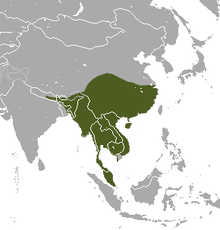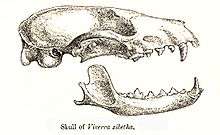Large Indian civet
| Large Indian civet | |
|---|---|
 | |
| Scientific classification | |
| Kingdom: | Animalia |
| Phylum: | Chordata |
| Class: | Mammalia |
| Order: | Carnivora |
| Family: | Viverridae |
| Subfamily: | Viverrinae |
| Genus: | Viverra |
| Species: | V. zibetha |
| Binomial name | |
| Viverra zibetha Linnaeus, 1758 | |
 | |
| Large Indian civet range | |
The large Indian civet (Viverra zibetha) is a civet native to South and Southeast Asia. It is listed as Least Concern on the IUCN Red List. The global population is considered decreasing mainly because of trapping-driven declines in heavily hunted and fragmented areas, notably in China, and the heavy trade as wild meat.[1]
Characteristics

The large Indian civet is grey or tawny and has a black spinal stripe running from behind the shoulders to the root of the tail. The front of the muzzle has a whitish patch emphasized by blackish behind on each side. The chin and fore throat are blackish. The sides and lower surface of the neck are banded with black stripes and white spaces in between. The tail has a variable number of complete black and white rings. Its claws are retractable. The soles of the feet are hairy.[2]
Its head-and-body length ranges from 50 to 95 cm (20 to 37 in) with a 38 to 59 cm (15 to 23 in) long tail. The hind foot measures 9 to 14.5 cm (3.5 to 5.7 in). Its weight ranges from 3.4 to 9.2 kg (7.5 to 20.3 lb).[3]
Distribution and habitat
The large Indian civet ranges from Nepal, northeast India, Bhutan, Bangladesh to Myanmar, Thailand, the Malay peninsula and Singapore to Cambodia, Laos, Vietnam and China.[1]
In Nepal, large Indian civet was recorded up to 2,250 m (7,380 ft) in the Himalayas, which constitutes the highest altitudinal record in this country.[4]
Distribution of subspecies
Five subspecies are recognized:[5]
- V. z. zibetha (Linnaeus, 1758) — ranges from Nepal eastwards to Assam;[6]
- V. z. ashtoni (Swinhoe, 1864) — inhabits China;[6]
- V. z. picta (Wroughton, 1915) — ranges from Assam and northern Myanmar to Indochina;[6]
- V. z. pruinosa (Wroughton, 1917) — inhabits Tenasserim and Peninsular Malaysia;[6]
- V. z. hainana (Wang and Xu, 1983)
Six subspecies have been proposed but a taxonomic revision is needed. The validity of the species Viverra tainguensis described in 1997 by Sokolov, Rozhnov and Pham Chong from Tây Nguyên in Gia Lai Province in Vietnam has been seriously questioned, and it is now generally considered a synonym of V. zibetha.[1]
Ecology and behaviour
The Large Indian civet is solitary and nocturnal. It spends most of the time on the ground. Its diet includes fish, birds, lizards, frogs, insects, scorpions and other arthropods, crabs, as well as poultry and rubbish. Little is known about its breeding behaviour. It is thought that it breeds throughout the year and has two litters per year, with two to four young per litter.[7]
Radio-tracked large Indian civets in Thailand had home ranges of 2.7 to 8.8 km2 (1.0 to 3.4 sq mi).[8]
Conservation

Viverra zibetha is totally protected in Malaysia under the Wildlife Protection Act of 1972 and listed on Category II of the China Wildlife Protection Law. China listed it as ‘Endangered’ under criteria A2acd, and it is a class II protected State species (due to trapping for food and scent glands). It is protected in Thailand, Vietnam and Myanmar. It is found in several protected areas throughout its range. The population of India is listed on CITES Appendix III.[1]
In Hong Kong, it is a protected species under the Wild Animals Protection Ordinance Cap 170, though it has not been recorded in a natural state in Hong Kong since the 1970s, and is considered extirpated.[9]
Local names
In Assamese it is called Gendera or Johamol.
In Bengali it is called Baghdas, Bham or Bham Biral and Gandho Gokul or Khatas. Biral= cat, Gandho= smell or scent. Gokul= the place of Lord Krishna (Govinda). In Bengal there is a delicate variety of sweet and pleasant smelling rice known as Govindabhog rice (the rice which is offered to Lord Govinda). The secretion from prene gland of civet cat smells like that variety of rice, so it is often called as "Gandho Gokul".
In Malay language it is called Musang kasturi (musang = civet, kasturi = musk), due to its musky smell.
In Thai, it is called chamot phaeng hang plong (ชะมดแผงหางปล้อง; pronounced [tɕʰa.mót.pʰɛ̌ːŋ.hǎːŋ.plɔ̂ŋ]; lit. "circular tailed/maned genet")
In Lao, it is called ngen phaeng hang kan (ເຫງັນແຜງຫາງກ່ານ; pronounced [ŋěn.pʰɛ̌ːŋ.hǎːŋ.kāːn]; lit. "stripe-tailed/maned civet")
In Tamil it is called Punugu Poonai (புனுகு பூனை).
References
- 1 2 3 4 5 Timmins, R.J.; Duckworth, J.W.; Chutipong, W.; Ghimirey, Y.; Willcox, D.H.A.; Rahman, H.; Long, B. & Choudhury, A. (2016). "Viverra zibetha". IUCN Red List of Threatened Species. Version 2016.2. International Union for Conservation of Nature.
- ↑ Pocock, R. I. (1939). Viverra zibetha Linnaeus. The Large Indian Civet. In: The fauna of British India, including Ceylon and Burma. Mammalia. – Volume 1. Taylor and Francis, London.
- ↑ Smith, A. T., Xie, Y. (2008). A guide to the mammals of China. Princeton University Press.
- ↑ Appel, A.; Werhahn, G.; Acharya, R.; Ghimirey, Y.; Adhikary, B. (2013). "Small carnivores in the Annapurna Conservation Area, Nepal" (PDF). Vertebrate Zoology. 63 (1): 111–121.
- ↑ Wozencraft, W.C. (2005). "Order Carnivora". In Wilson, D.E.; Reeder, D.M. Mammal Species of the World: A Taxonomic and Geographic Reference (3rd ed.). Johns Hopkins University Press. pp. 532–628. ISBN 978-0-8018-8221-0. OCLC 62265494.
- 1 2 3 4 Ellerman, J. R., Morrison-Scott, T. C. S. (1966). Checklist of Palaearctic and Indian mammals 1758 to 1946. Second edition. British Museum of Natural History, London. Page 281.
- ↑ Lekagul, B. and McNeely, J.A. (1977). Mammals of Thailand. Association for the Conservation of Wildlife, Bangkok.
- ↑ Simcharoen, S. (1999). Home range size, habitat utilization and daily activities of Large Indian Civet (Viverra zibetha). Research and progress report year 1999, Wildlife Research Division, Department of National Parks, Wildlife and Plant Conservation, Bangkok.
- ↑ Shek, C. T. (2006). A Field Guide to the Terrestrial Mammals of Hong Kong. Friends of the Country Parks / Cosmos Books, Hong Kong. 403 pp. ISBN 978-988-211-331-2. Page 281
External links
| Wikispecies has information related to: Viverra zibetha |
